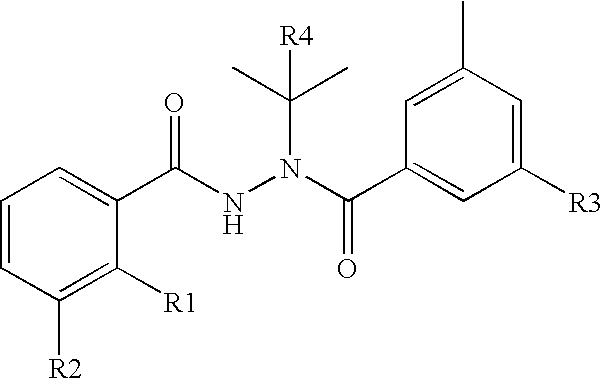Mutant receptors and their use in a nuclear receptor-based inducible gene expression system
a gene expression system and nuclear receptor technology, applied in the field of biotechnology or genetic engineering, can solve the problems of system limitation, leakage of system, limited use of pr1-a,
- Summary
- Abstract
- Description
- Claims
- Application Information
AI Technical Summary
Benefits of technology
Problems solved by technology
Method used
Image
Examples
example 1
[0261]This Example describes the construction of several gene expression cassettes comprising novel substitution mutant Group H nuclear receptor polynucleotides and polypeptides of the invention for use in a nuclear receptor-based inducible gene expression system. Applicants constructed gene expression cassettes based on the spruce budworm Choristoneura fumiferana EcR (“CfEcR). The prepared receptor constructs comprise a ligand binding domain of either an EcR or a chimera of Homo sapiens RXRβ-LmRXR; and a GAL4 DNA binding domain (DBD) or a VP16 transactivation domain (AD). The reporter constructs include the reporter gene luciferase operably linked to a synthetic promoter construct that comprises a GAL4 response element to which the Gal4 DBD binds. Various combinations of these receptor and reporter constructs were cotransfected into mammalian cells as described in Examples 2-5 infra.
[0262]Gene Expression Cassettes: Ecdysone receptor-based gene expression cassettes (switches) were c...
example 2
[0271]This Example describes the identification of ecdysteroid responsive CfEcR ligand binding domain substitution mutants that exhibit increased activity in response to ecdysteroidal ligand. In an effort to identify substitution mutations in the CfEcR that increase ecdysteroidal ligand activity, Applicants mutated amino acid residues predicted to be critical for ecdysteroid binding and created GAL4 / mutantCfEcR-DEF cDNA gene expression cassettes as described in Example 1 above using PCR-mediated site-directed mutagenesis kit. The mutated and the WT cDNAs corresponding to the various switch constructs outlined above in Example were made and tested in GAL4-driven luciferase reporter assays as described below.
[0272]Transfections: DNAs were transfected into mouse NIH3T3 cells (ATCC) as follows. Standard methods for culture and maintenance of the cells were followed. Cells were harvested and plated 96-well plates at 2,500 cells per well, in 50 μL of growth medium containing 10% fetal bov...
example 3
[0298]This Example describes the identification of CfEcR ligand binding domain substitution mutants that are generally ecdysteroid responsive that exhibit increased activity in response to ecdysteroids. In an effort to identify substitution mutations in the CfEcR that increase ecdysteroid activity, Applicants mutated amino acid residues and created GAL4 / mutant CfEcR-DEF cDNA gene expression cassettes as described in Example 1 above using PCR-mediated site-directed mutagenesis kit. The mutated and the WT cDNAs corresponding to the various switch constructs outlined above in Example 1.1 and 1.2 were made and tested in a GAL4-driven luciferase reporter assay as described in Example 2.
[0299]Specific amino acid residues were identified that, when substituted, yield a mutant ecdysone receptor that exhibits increased activity in response to an ecdysteroid ligand. The effect of an amino acid substitution at amino acid residue 119 of SEQ ID NO: 1 on the activity of the mutated CfEcR-DEF rece...
PUM
| Property | Measurement | Unit |
|---|---|---|
| Tm | aaaaa | aaaaa |
| Tm | aaaaa | aaaaa |
| Tm | aaaaa | aaaaa |
Abstract
Description
Claims
Application Information
 Login to View More
Login to View More - R&D
- Intellectual Property
- Life Sciences
- Materials
- Tech Scout
- Unparalleled Data Quality
- Higher Quality Content
- 60% Fewer Hallucinations
Browse by: Latest US Patents, China's latest patents, Technical Efficacy Thesaurus, Application Domain, Technology Topic, Popular Technical Reports.
© 2025 PatSnap. All rights reserved.Legal|Privacy policy|Modern Slavery Act Transparency Statement|Sitemap|About US| Contact US: help@patsnap.com



